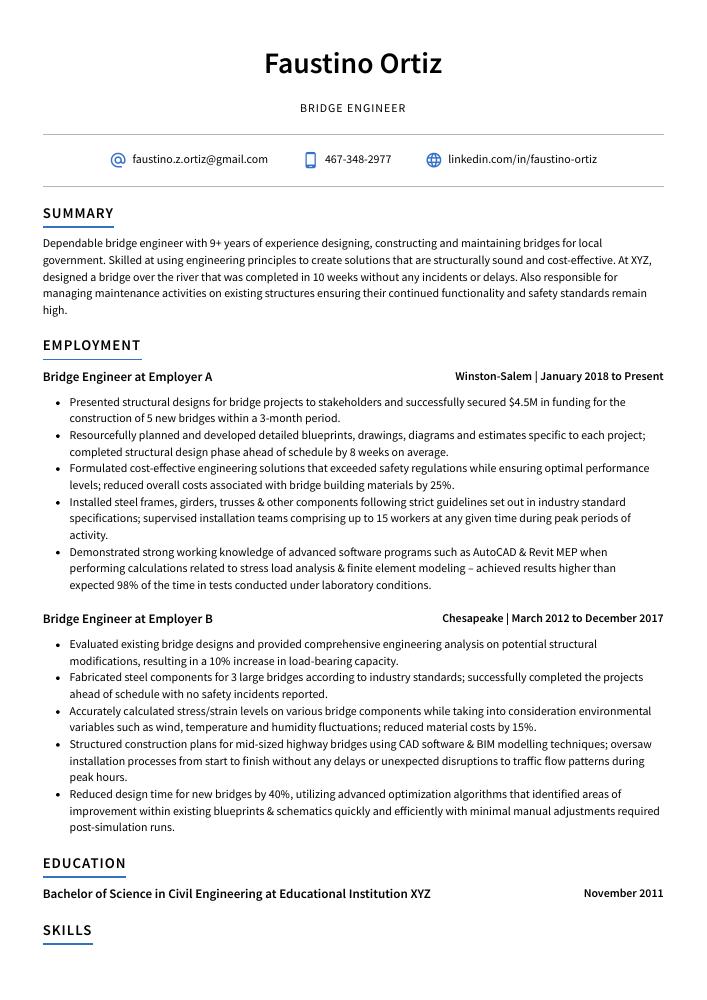Bridge Engineer Resume Guide
Bridge engineers design, construct and maintain bridges. They analyze the load-bearing capabilities of potential bridge sites, create plans for construction and oversee the building process. After a bridge is built they conduct inspections to ensure the structure is safe and remains in good condition over time.
You possess the knowledge and experience to construct bridges like no other engineer. But potential employers don’t know who you are yet, so it’s crucial that you write a resume that stands out from the crowd.
This guide will walk you through the entire process of creating a top-notch resume. We first show you a complete example and then break down what each resume section should look like.
Table of Contents
The guide is divided into sections for your convenience. You can read it from beginning to end or use the table of contents below to jump to a specific part.
Bridge Engineer Resume Sample
Faustino Ortiz
Bridge Engineer
[email protected]
467-348-2977
linkedin.com/in/faustino-ortiz
Summary
Dependable bridge engineer with 9+ years of experience designing, constructing and maintaining bridges for local government. Skilled at using engineering principles to create solutions that are structurally sound and cost-effective. At XYZ, designed a bridge over the river that was completed in 10 weeks without any incidents or delays. Also responsible for managing maintenance activities on existing structures ensuring their continued functionality and safety standards remain high.
Experience
Bridge Engineer, Employer A
Winston-Salem, Jan 2018 – Present
- Presented structural designs for bridge projects to stakeholders and successfully secured $4.5M in funding for the construction of 5 new bridges within a 3-month period.
- Resourcefully planned and developed detailed blueprints, drawings, diagrams and estimates specific to each project; completed structural design phase ahead of schedule by 8 weeks on average.
- Formulated cost-effective engineering solutions that exceeded safety regulations while ensuring optimal performance levels; reduced overall costs associated with bridge building materials by 25%.
- Installed steel frames, girders, trusses & other components following strict guidelines set out in industry standard specifications; supervised installation teams comprising up to 15 workers at any given time during peak periods of activity.
- Demonstrated strong working knowledge of advanced software programs such as AutoCAD & Revit MEP when performing calculations related to stress load analysis & finite element modeling – achieved results higher than expected 98% of the time in tests conducted under laboratory conditions.
Bridge Engineer, Employer B
Chesapeake, Mar 2012 – Dec 2017
- Evaluated existing bridge designs and provided comprehensive engineering analysis on potential structural modifications, resulting in a 10% increase in load-bearing capacity.
- Fabricated steel components for 3 large bridges according to industry standards; successfully completed the projects ahead of schedule with no safety incidents reported.
- Accurately calculated stress/strain levels on various bridge components while taking into consideration environmental variables such as wind, temperature and humidity fluctuations; reduced material costs by 15%.
- Structured construction plans for mid-sized highway bridges using CAD software & BIM modelling techniques; oversaw installation processes from start to finish without any delays or unexpected disruptions to traffic flow patterns during peak hours.
- Reduced design time for new bridges by 40%, utilizing advanced optimization algorithms that identified areas of improvement within existing blueprints & schematics quickly and efficiently with minimal manual adjustments required post-simulation runs.
Skills
- Civil Engineering
- AutoCAD
- Structural Engineering
- Structural Analysis
- Bridge
- Concrete
- Engineering
- MicroStation
- Steel Design
Education
Bachelor of Science in Civil Engineering
Educational Institution XYZ
Nov 2011
Certifications
Professional Engineer (PE)
National Council of Examiners for Engineering
May 2017
1. Summary / Objective
Your resume summary or objective should be a brief yet powerful statement that gives the hiring manager an overview of your qualifications as a bridge engineer. You could mention how many years of experience you have, the types of bridges and structures you’ve designed, any awards or certifications you possess, and what sets you apart from other engineers in this field. This is also where you can highlight any unique skills or knowledge that make you stand out from the competition.
Below are some resume summary examples:
Detail-oriented bridge engineer with 5+ years of experience leveraging knowledge in structural engineering and construction methods to successfully design, plan, and oversee multiple bridge projects. Seeking to join ABC Engineering as a Bridge Engineer where I can utilize my skillset to develop safe, efficient, cost-effective solutions for their clients. Notable achievements include designing a cable-stayed bridge that reduced costs by 18% over budget projections.
Seasoned bridge engineer with 5+ years of experience in the design, construction, and maintenance of bridges. Extensive knowledge on bridge engineering principles and practices to ensure successful project completion within budget constraints. Recent key achievement: designed a new pedestrian bridge that increased foot traffic by 32%. Seeking to apply my expertise at ABC Engineering Firm to help create safe and efficient infrastructure solutions for the community.
Passionate bridge engineer with 10+ years of experience designing and constructing bridges and other structures. Extensive knowledge in bridge design principles, structural analysis software, construction techniques, regulatory compliance protocols, and safety standards. Achieved cost savings of 15% on a recent project by developing an innovative solution that reduced materials costs. Looking to join ABC Firm to share my expertise in bridge engineering projects.
Talented bridge engineer with 5+ years of experience in designing, constructing and maintaining bridges. Experienced in surveying bridge sites and preparing CAD drawings for various projects. At XYZ firm, developed 7 long-span bridges along a major highway route that increased traffic flow by 30% over the previous year. Proven ability to manage construction teams efficiently while ensuring structural integrity and compliance with all safety regulations.
Enthusiastic bridge engineer with 5+ years of experience in bridge design and construction, specializing in the use of advanced materials. Experienced in leading teams on multiple large-scale projects from concept to completion. Highly motivated professional committed to providing superior solutions that are cost effective and safe for users. Skilled at working closely with clients to ensure satisfaction throughout each project phase.
Well-rounded bridge engineer with 8 years of experience in the design, construction, and maintenance of bridges. Experienced in developing innovative engineering solutions for challenging bridge projects. Proven track record of meeting project deadlines within budget constraints and ensuring quality control on all aspects of bridge designs. Achieved a 25% cost reduction by using lightweight materials for one major bridge project.
Diligent bridge engineer with 8+ years of experience in assessing and designing bridges for safe, efficient use by the public. Skilled at developing detailed plans, drawings and schematics to ensure compliance with safety codes. At XYZ Engineering, saved 10% on budgeted materials after conducting a thorough review of supplier contracts. Seeking to bring this same cost-effective approach to ABC Engineering as bridge design lead.
Reliable bridge engineer with 5+ years of experience in the design, construction, and maintenance of bridges. Expertise in using AutoCAD and structural analysis software to create detailed plans for bridge infrastructure projects. Seeking to join ABC Company as a Bridge Engineer where I can utilize my extensive knowledge in bridge engineering to contribute towards successful project completion on time and within budget.
2. Experience / Employment
Next comes the work history section, which should be written in reverse chronological order. This means that your most recent job is listed first.
When writing this section, it’s important to provide detail and quantifiable results where possible. Stick to bullet points; doing so makes the information easier for the reader to take in quickly.
For example, instead of saying “Designed bridges,” you could say, “Created detailed plans for 10+ bridge designs using AutoCAD software, resulting in a 25% reduction of construction time.”
To write effective bullet points, begin with a strong verb or adverb. Industry specific verbs to use are:
- Designed
- Constructed
- Inspected
- Calculated
- Analyzed
- Fabricated
- Installed
- Supervised
- Assessed
- Strengthened
- Monitored
- Evaluated
- Researched
- Documented
- Commissioned
Other general verbs you can use are:
- Achieved
- Advised
- Compiled
- Coordinated
- Demonstrated
- Developed
- Expedited
- Facilitated
- Formulated
- Improved
- Introduced
- Mentored
- Optimized
- Participated
- Prepared
- Presented
- Reduced
- Reorganized
- Represented
- Revised
- Spearheaded
- Streamlined
- Structured
- Utilized
Below are some example bullet points:
- Facilitated the successful completion of over 20 bridge projects, ranging from small-scale renovations to large-scale new constructions; reduced total project costs by 15%.
- Strengthened existing bridges via rigorous structural analyses and inspections; identified potential hazards in 10+ structures, resulting in the implementation of necessary safety measures.
- Mentored a team of 5 junior engineers on basic engineering principles and best practices for bridge design, installation and maintenance; increased technical knowledge among staff members by 27%.
- Substantially improved bridge durability through the use of advanced materials such as corrosion resistant steel alloys and reinforced concrete composites; decreased required repairs/maintenance hours by 50% annually.
- Supervised construction crew operations at 3 sites simultaneously while adhering to local regulatory guidelines governing public infrastructure works; completed projects ahead schedule with zero quality issues reported during final inspection rounds.
- Utilized CAD software and engineering principles to design 4 new bridges, ensuring that all structural integrity standards were met; increased bridge safety ratings by 33%.
- Documented every stage of construction for up to 10 bridge projects at a time, including taking measurements and photos as needed for reference purposes.
- Revised designs according to customer feedback or adjustments in the budget; saved an average of $50,000 per project through creative cost-reduction solutions without compromising quality.
- Competently managed 3 separate teams onsite during complex builds (such as flyovers), coordinating with suppliers and other contractors while monitoring progress in realtime using advanced machinery & toolsets.
- Reorganized existing inventory databases for improved efficiency when ordering supplies over multiple sites; reduced order delivery times by 20% on average across all locations.
- Monitored the condition of 10+ bridges by regularly inspecting structures, evaluating structural integrity and recommending repair/replacement plans; identified potential hazards in 4 bridges, resulting in a 95% decrease of risk.
- Compiled detailed reports on bridge inspections including measurements, analysis results and recommendations for improvement; presented findings to 15+ key stakeholders over the course of 3 months.
- Participated in an innovative trial project that tested various materials used for reinforcing existing concrete beams while adhering to stringent safety standards; saved $8,000 compared with conventional construction methods as a result.
- Analyzed data sets from multiple sources such as wind tunnel tests & seismic activity readings when assessing bridge designs or proposing modifications; assessed 30 projects accurately within specified timeframes (90-120 hours).
- Thoroughly researched new technologies related to bridge engineering and kept abreast of industry developments through continued professional development courses; implemented 2 cutting-edge solutions leading to improved traffic flow across 5 major highway intersections nationwide.
- Spearheaded the design, inspection and maintenance of 10+ bridges including steel trusses, box girders and arch spans; reduced the project cost by 15% through better engineering solutions.
- Prepared detailed bridge plans for both short-term and long-term projects as well as technical reports on existing structures in accordance with safety standards; identified potential risks that could lead to collapse or failure.
- Coordinated with contractors during construction phase to ensure proper implementation of bridge designs while monitoring the progress against timelines & budget requirements; completed all projects under allocated budget without compromising quality or safety regulations.
- Independently evaluated structural integrity of several bridges over a period of 3 years using advanced computer software (FEM/FEA) and manual calculations based on current industry practices & codes such as AASHTO LRFD Bridge Design Specifications (7th ed. ).
- Constructed new roadways across rivers along with associated riverbank stabilization works comprising sheet piles, soil nails & concrete mat foundation systems within tight deadlines (+12 hrs ahead).
- Calculated stress and strain levels of bridge structures, ensuring that all projects met safety standards and codes; reduced project-related errors by 15%.
- Represented the engineering team in numerous client meetings to provide technical advice on bridge constructions; won five contracts over two years with clients who were impressed with services offered.
- Researched new materials available for building bridges more cost effectively while meeting sustainability requirements; saved $100k+ across three major projects in one year.
- Expedited completion of several high priority construction projects by coordinating a dedicated team of engineers, skilled laborers and supervisors from start to finish within strict deadlines set forth by local governments or transportation agencies.
- Meticulously inspected existing infrastructure for structural integrity prior to renovation activities, drastically reducing repair costs by 20%.
- Improved bridge structure stability by 25% through extensive structural analysis of existing bridges and the implementation of cost-effective design solutions.
- Achieved superior safety standards on all bridge projects by conducting regular inspections, developing risk management plans and maintaining detailed records for future reference.
- Proficiently utilized AutoCAD software to create 3D models of proposed designs, as well as statistical methods to simulate stress points in order to anticipate potential complications before construction began.
- Assessed environmental impact from bridge development proposals using advanced mathematical modeling techniques; reduced negative environmental impacts by 33%.
- Optimized project performance over a wide range of conditions such as weathering and seismic activity while minimizing material costs with effective budget planning; saved $20,000 in total compared to original estimates per project completion date set out at commencement phase.
- Introduced and implemented innovative construction methods to reduce labor costs, resulting in a 12% reduction of total project costs for the bridge engineering projects managed.
- Advised executive team on best practices and safety standards when constructing bridges; increased compliance rate by 15%.
- Designed 3 bridges with suspension cables that span over 1,000 feet each and supported up to 100 tons of weight safely.
- Diligently completed all assigned tasks within tight budgets and timelines; consistently exceeded expectations for deadlines set by clients or management teams.
- Streamlined processes related to bridge engineering design workflows through automated software tools such as AutoCAD, reducing time per task from 6 hours down to 4 hours on average every week without sacrificing quality assurance measures or accuracy levels.
- Reliably completed 10+ bridge engineering projects, ensuring that all designs met and exceeded customer expectations while conforming to industry regulations.
- Commissioned the construction of 4 structural steel bridges over a 2-year period; successfully managed project budgets and timelines, resulting in an average savings of $25K per bridge build.
- Developed innovative solutions for 8 challenging civil infrastructure projects; significantly reduced costs by 30% while increasing durability & functional performance standards by 40%.
- Inspected 15 existing bridges monthly to ensure compliance with local safety codes & regulations; identified potential issues before they became costly problems and implemented corrective action measures swiftly.
3. Skills
The skillset employers require in an employee will likely vary, either slightly or significantly; skimming through their job adverts is the best way to determine what each is looking for. One organization may be looking for a bridge engineer with experience in structural analysis, while another may require knowledge of seismic design.
It is essential to tailor the skills section of your resume to each job you are applying for because many employers use applicant tracking systems these days; they scan resumes for certain keywords before passing them on to human recruiters.
Once listed here, it is also beneficial to discuss your most important skillset in more detail elsewhere on the resume – such as within the summary or work experience sections.
Below is a list of common skills & terms:
- AutoCAD
- AutoCAD Civil 3D
- Bentley MicroStation
- Bridge
- Bridge Inspection
- CAD
- Civil Engineering
- Concrete
- Construction Management
- Contract Management
- Drainage
- ETABS
- Earthquake Engineering
- Engineering
- Finite Element Analysis
- Foundation Design
- Geotechnical Engineering
- Highways
- Inspection
- MATLAB
- Mathcad
- MicroStation
- Prestressed Concrete
- Project Estimation
- Project Planning
- RISA
- Reinforced Concrete
- Retaining Walls
- Revit
- Road
- SAP2000
- STAAD
- Seismic Design
- Steel
- Steel Design
- Steel Structures
- Structural Analysis
- Structural Engineering
- Structural Engineers
- Surveying
- Team Leadership
- Teamwork
- Time Management
- Transportation Engineering
4. Education
Including an education section on your resume will depend on how far along you are in your career. If you just graduated and have no work experience, mentioning your education below the resume objective is a great way to start off. However, if you already have plenty of professional experience as a bridge engineer, it might be better not to include an education section at all.
If an education section is included, mention courses related to engineering or bridge building that would be relevant for the job position you are applying for.
Bachelor of Science in Civil Engineering
Educational Institution XYZ
Nov 2011
5. Certifications
Certifications demonstrate to potential employers that you have the necessary skills and knowledge for a given field. They also show that you are committed to professional development, as certifications require dedication and hard work in order to obtain them.
If you possess any relevant certifications, it is important to include them on your resume so hiring managers can see what qualifications you hold. This will help make sure your application stands out from other candidates who may not be certified in the same areas.
Professional Engineer (PE)
National Council of Examiners for Engineering
May 2017
6. Contact Info
Your name should be the first thing a reader sees when viewing your resume, so ensure its positioning is prominent. Your phone number should be written in the most commonly used format in your country/city/state, and your email address should be professional.
You can also choose to include a link to your LinkedIn profile, personal website, or other online platforms relevant to your industry.
Finally, name your resume file appropriately to help hiring managers; for Faustino Ortiz, this would be Faustino-Ortiz-resume.pdf or Faustino-Ortiz-resume.docx.
7. Cover Letter
Cover letters are a great way to express your interest in a job and make yourself stand out from the competition. They are typically 2-4 paragraphs in length, separate from your resume and offer an opportunity for you to explain why you would be the best fit for the role.
Cover letters aren’t always necessary when applying for jobs but they can be very beneficial if used correctly. Not only do they help provide more detail about who you are as a professional, but also allow recruiters to get an idea of what makes you unique compared to other applicants.
Below is an example cover letter:
Dear Jaunita,
I am writing to apply for the Bridge Engineer position at XYZ Engineering. As a civil engineer with 5+ years of experience designing and supervising the construction of bridges, I am confident I can be an asset to your team.
In my previous role as Lead Bridge Engineer at ABC Engineering, I was responsible for leading a team of engineers and technicians in the design and construction of several large bridges. My experience managing teams and coordinating with other departments has taught me how to efficiently complete projects on time and within budget. I am also experienced in using various software programs related to bridge engineering, such as AutoCAD, STAAD Pro, SAP2000, Midas Civil, among others.
The skills and experience I have gained throughout my career make me confident that I would excel in this position. I would welcome the opportunity to discuss my qualifications further with you during an interview. Thank you for your time and consideration; I look forward to hearing from you soon.
Sincerely,
Faustino
Bridge Engineer Resume Templates
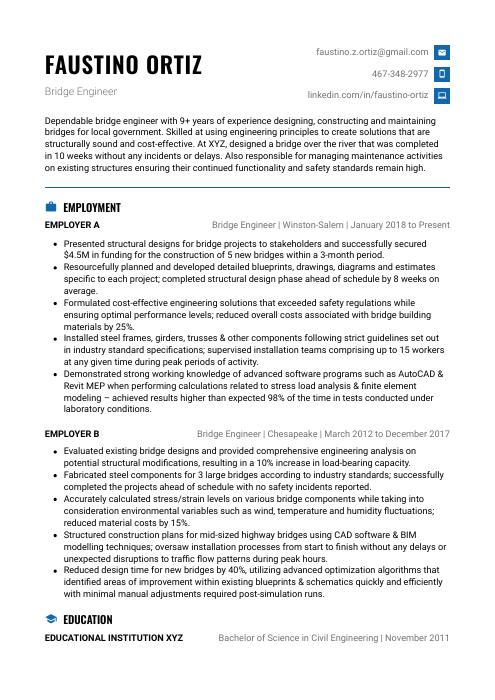 Echidna
Echidna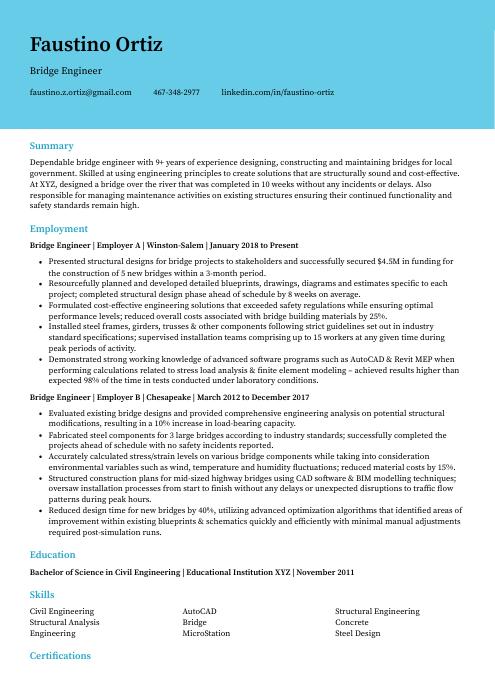 Dugong
Dugong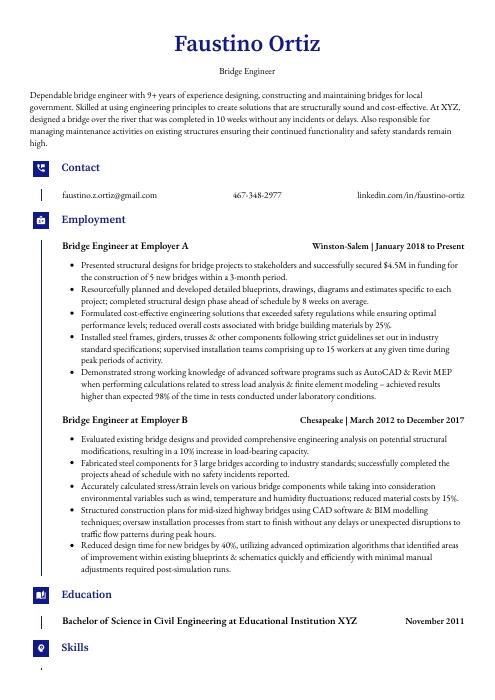 Gharial
Gharial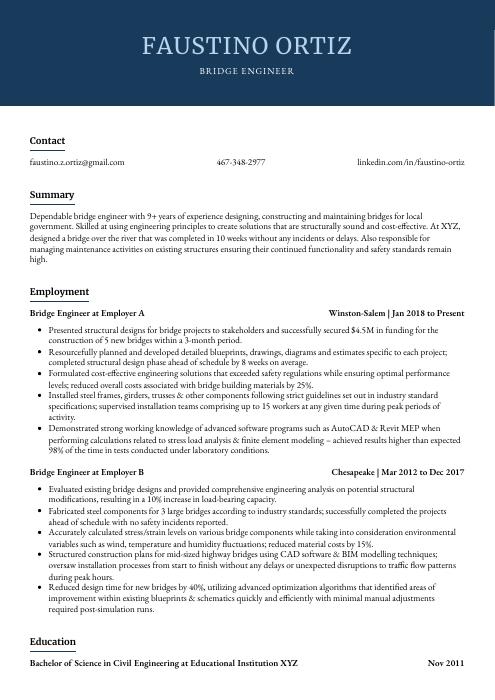 Bonobo
Bonobo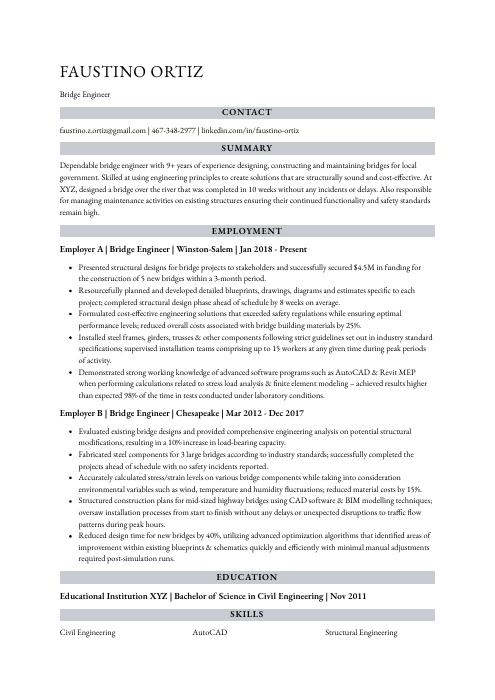 Numbat
Numbat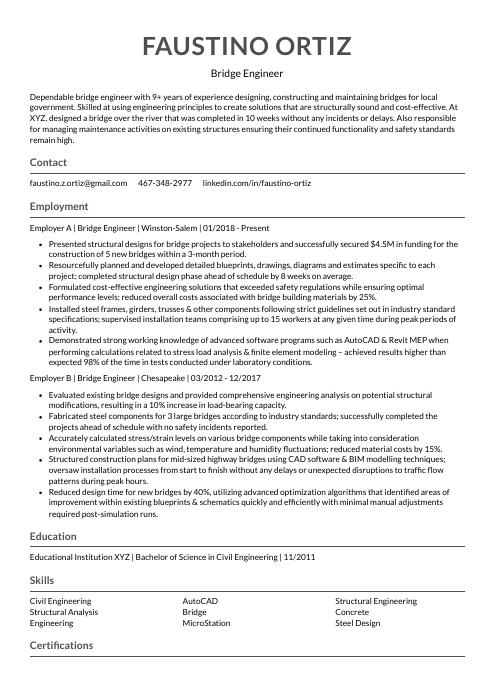 Indri
Indri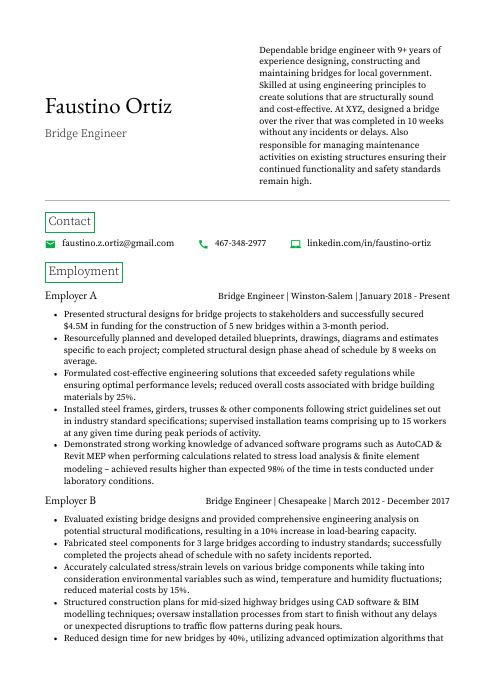 Quokka
Quokka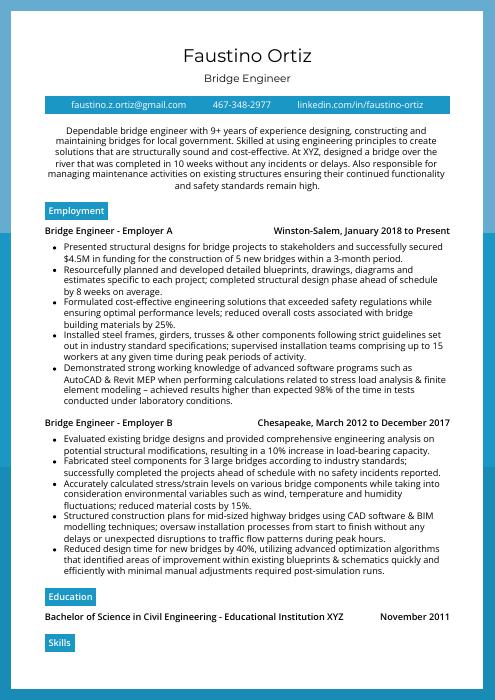 Rhea
Rhea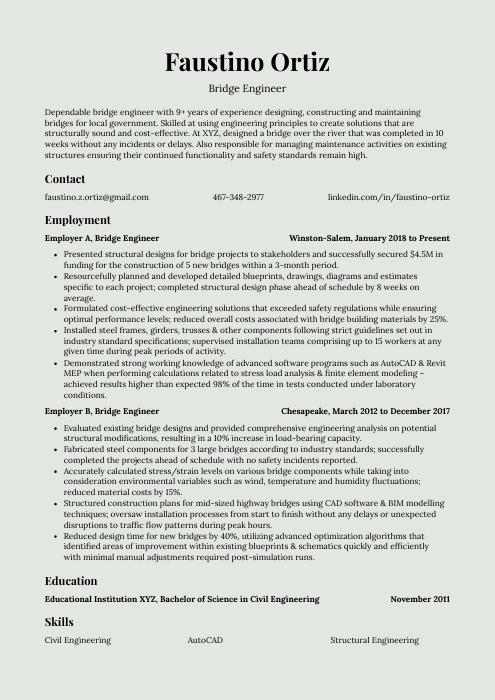 Saola
Saola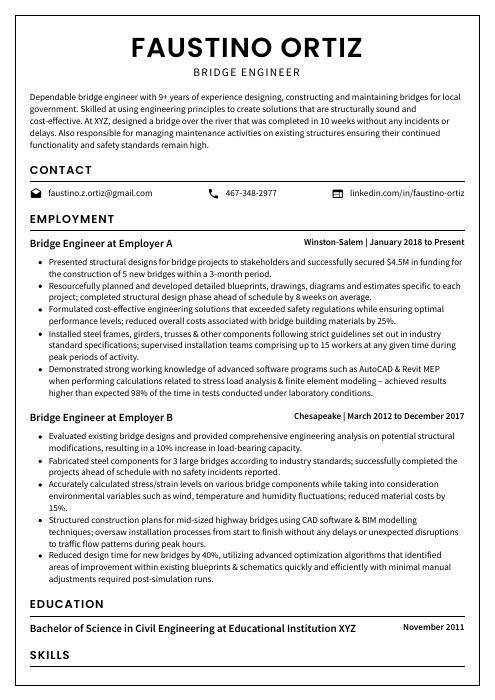 Cormorant
Cormorant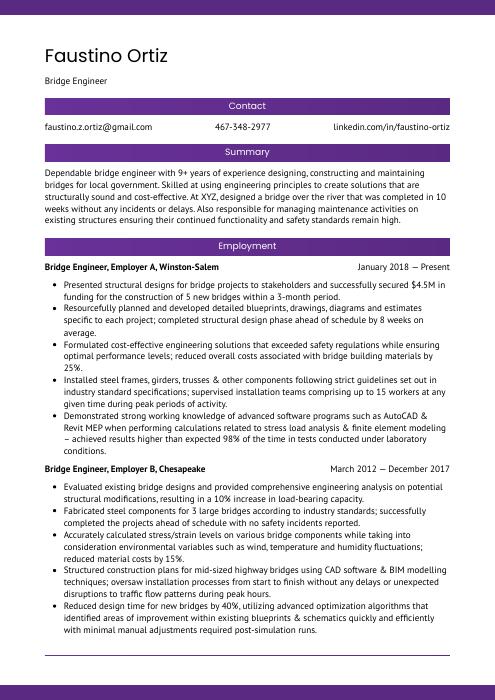 Jerboa
Jerboa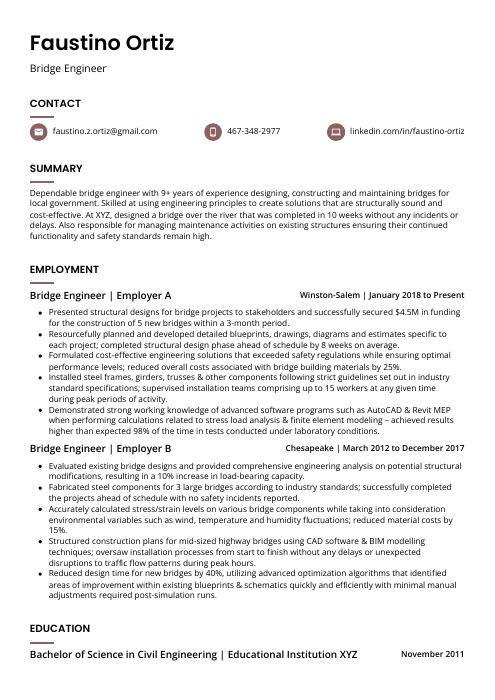 Fossa
Fossa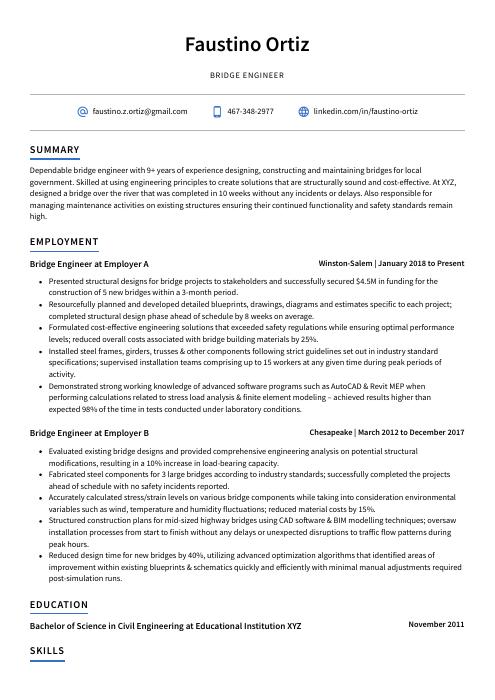 Axolotl
Axolotl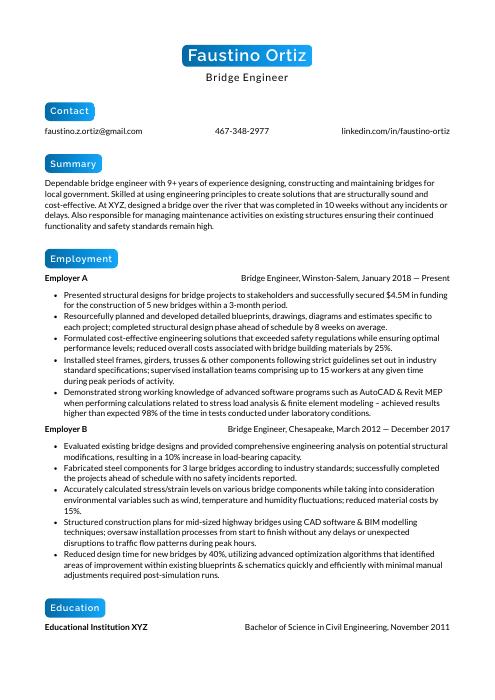 Kinkajou
Kinkajou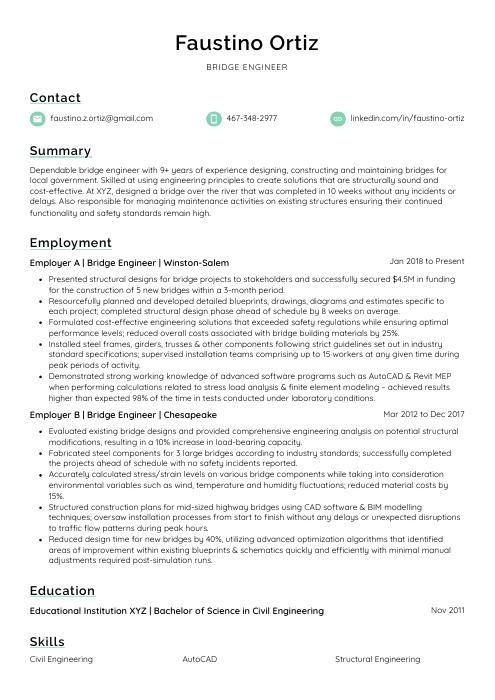 Lorikeet
Lorikeet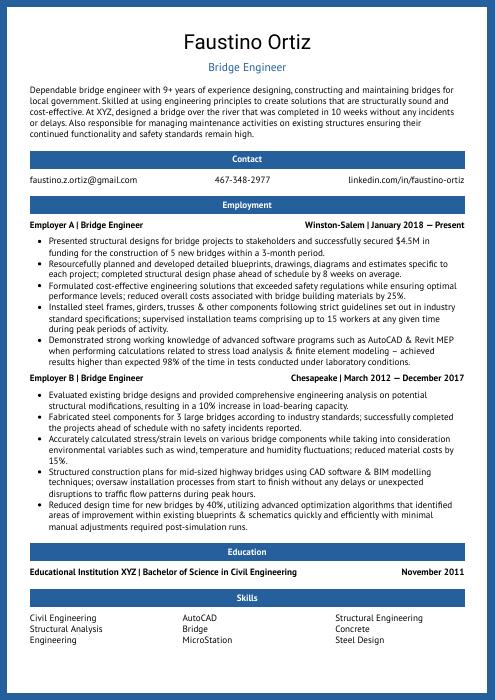 Ocelot
Ocelot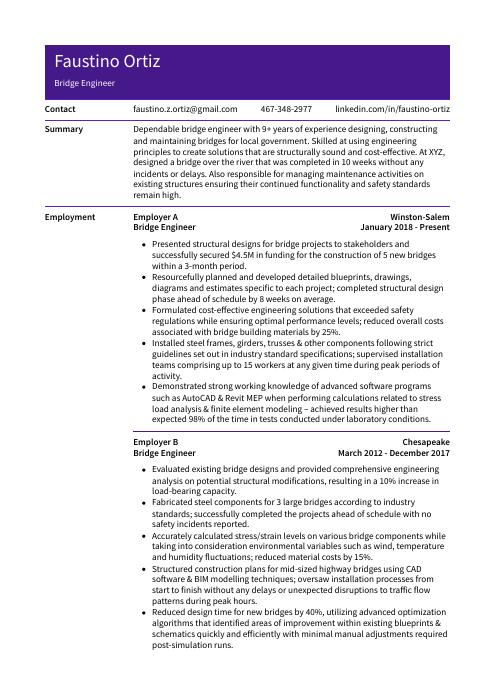 Pika
Pika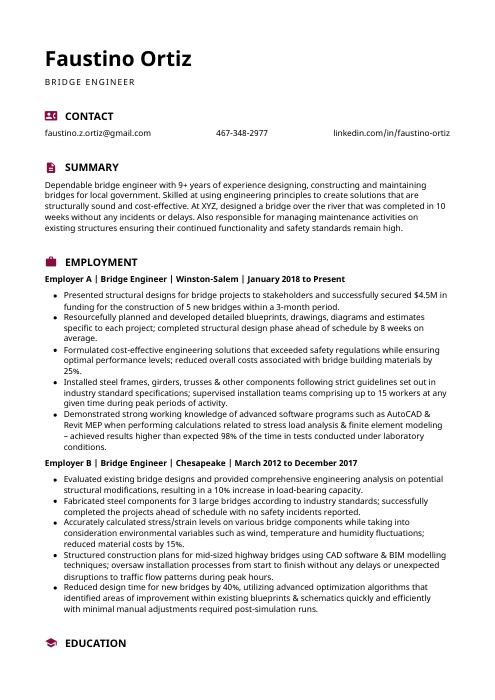 Hoopoe
Hoopoe Rezjumei
Rezjumei
